 |
 |
 |
| |
Immunodeficiency and Risk of AIDS-defining and Non-AIDS-defining Cancers: ANRS CO3 Aquitaine Cohort, 1998 to 2006
|
| |
| |
Reported by Jules Levin
15th CROI, Feb 3-6, 2008, Boston
M Bruyand1,2, R Thiebaut1,2,3,4, S Lawson-Ayayi1,2, P Joly3,4, A Sasco5, J L Pellegrin2,4,6, D Neau2,4,6, P Morlat1,2,4,6, G Chene1,2,4, Fabrice Bonnet*1,2,4,6, and Groupe d'Epidemiologie Clinique du SIDA en Aquitaine (GECSA)
1INSERM U593 and CIC-EC7, Bordeaux, France; 2Ctr Hosp Univ Bordeaux, France; 3INSERM U875, Bordeaux, France; 4Univ Victor Segalen, Bordeaux, France; 5INSERM U897, Bordeaux, France; and 6Ctr Hosp Univ Bordeaux, France
from Jules Levin: study findings. Longer duration of immunosupression, CD4 count (<200), associated with AIDS cancers; as well, longer duration of HIV RNA viral load >500 and >10,000 (more risky) also associated with increased risk for AIDS cancer. Regarding non-AIDS cancer, there is an increased risk associated with longer duration of CD4 is <200 or <500, risk appears to trend greater if CD4 is <200 than <500. There was not a significant association with uncontrolled HIV RNA viral load and risk for non-AIDS cancer. Use of HAART even with viral load >500 or >10,000 appears (trend) to have benefits in that risk for AIDS cancers is lower with longer duration on HAART. The authors conclude: "higher incidence of AIDS cancer in case of longstanding uncontrolled HIV RNA viral load whatever the CD4 count, this could explain in part AIDS cancer in patients moderately immunosuppressed" Author also said history of immunosuppression was better marker for risk than current CD4 count, in response to question after talk. He also said in response to question, he would need to look at a similar analysis with regards to HIV RNA being <50 c/ml but when they started the study <500 c/ml was the marker.
ABSTRACT
Background: HIV-infected patients have a high risk of AIDS- and non-AIDS-defining cancers. Besides traditional determinants, a specific role of HIV, immunodepression, and ART cannot be excluded. We aimed at studying the association between the risk of AIDS- and non-AIDS-defining cancers and either immuno-virological characteristics, or treatment history of HIV-infected patients.
Methods: Patients from the ANRS CO3 Aquitaine Cohort were included in the analyses if the duration of follow-up was >3 months, if they had at least 2 follow-up visits available during the study period (1998 to 2006) and if 1 HIV RNA viral load was collected within the first follow-up visit. Duration of exposure was calculated as the time duration with CD4 count or HIVRNA level above or below different thresholds. Multivariate modelling was based on extended Cox proportional hazards models for time-dependent covariates and delayed entry (at time of first available HIV RNA measurement).
Results: Among the 4194 patients included, 251 cancers (109 AIDS-defining and 142 non-AIDS-defining) were reported.
Regarding AIDS-defining cancers, a higher incidence was independently associated with a longer duration of HIV RNA >500 copies/mL: relative risk (RR) = 1.20 per year of exposure (95% confidence interval [CI] 1.10 to 1.31, p <10-3) and a longer duration of CD4 count <200/mm3: RR = 1.35 by year of exposure (CI 1.20 to 1.53, p <10-3). A lower incidence was associated with duration of exposure to combination ART (cART): RR = 0.82 per year (CI 0.74 to 0.91, p <10-3).
Regarding non-AIDS-defining cancers, a higher incidence was independently associated with a longer duration of CD4 count <200/mm3: RR = 1.16 per year of exposure (CI 1.03 to 1.30, p = 0.01) or a longer duration of CD4 count <500/mm3: RR = 1.11 per year of exposure (CI 1.01 to 1.22, p = 0.02), and a lower incidence with female gender: RR = 0.58 (CI 0.37 to 0.92, p = 0.02). HIV RNA and cART were not associated with the risk of non-AIDS-defining cancers.
Conclusions: A longer exposure to uncontrolled HIV RNA was associated with a higher risk of AIDS-defining cancers, independently of CD4 count. Moreover, prolonged immunosuppression was associated with a higher risk of cancers of both types, regardless of the CD4 count threshold considered. ART should aim at reaching and maintaining the CD4 count >500/mm3 to prevent the occurrence of all cancers, in addition to other prevention policies.

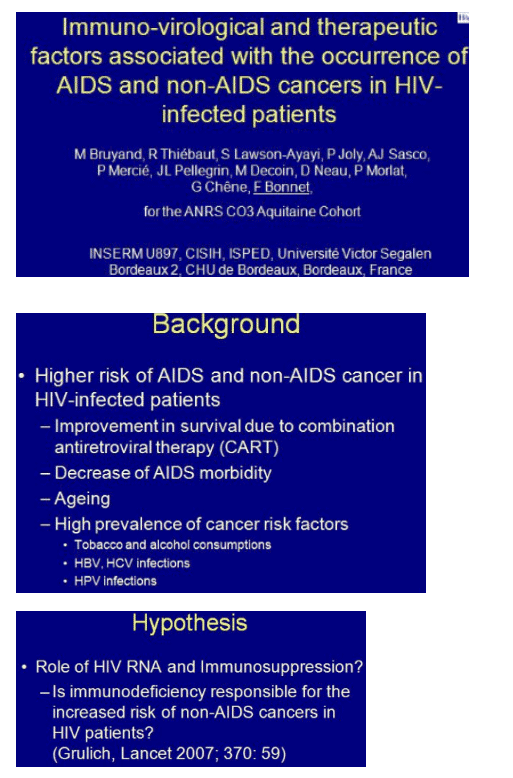
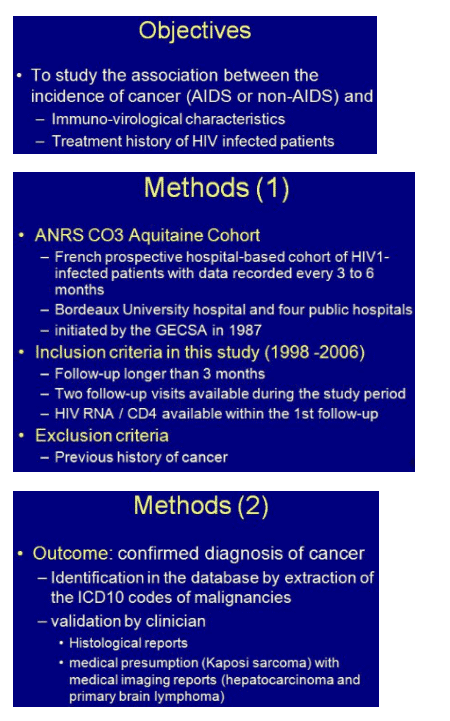
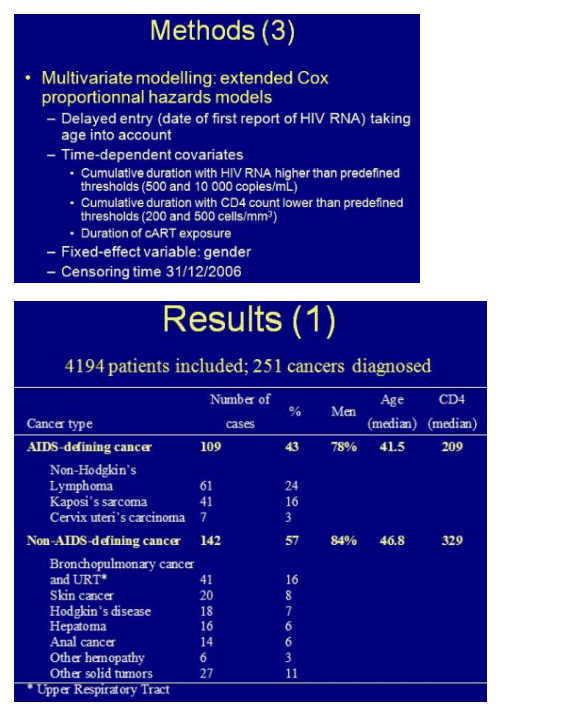
One year with CD4 count <200 or 1 year with HIV RNA >500 is associated with a significant increased risk for AIDS cancers with both adjusted and unadjusted analysis. Regarding non-AIDS cancers, 1 year with CD4 count <500 is associated with a significant increased risk for non-AIDS cancers in both adjusted & unadjusted analyses. For patients with 1 year of HIV-RNA >500 there is a significant increased risk for non-AIDS cancers in the unadjusted analysis that disappears in the adjusted analysis.
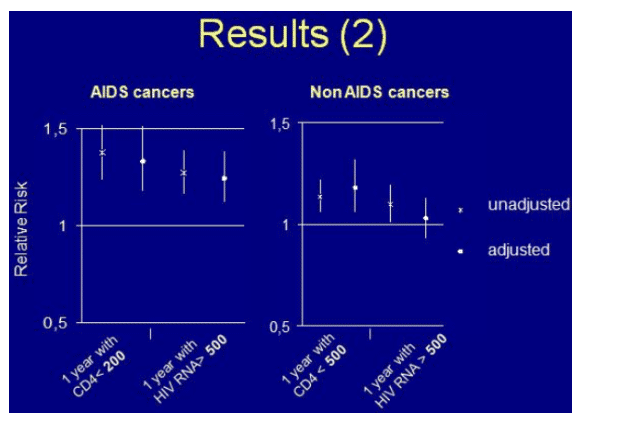
The risk of AIDS cancer is independently associated with HIV RNA >500 opies/ml and the risk is greater for every year with HIV RNA >10,000 c/ml. Although the speaker said risk increased for every year with HIV RNA >10,000 based on the table my interpretation is that there is also an increased risk for every year with HIV RNA >500 c/ml. CD4 <200 in patients with >500 c/ml ewas a strong predictor of AIDS cancer', 1.33 RR (p<0.0001); in patients with 10,000 HIV RNA CD4 <200: 1.20 RR (p=0.0086).
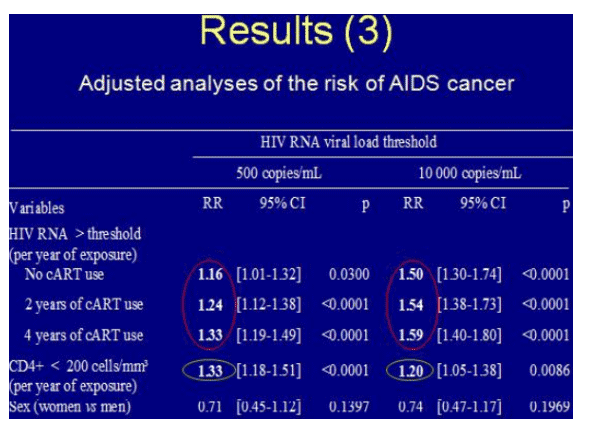
Regarding non-AIDS cancers. Longer exposure to CD4 <200 is associated with significant increased risk for non-AIDS cancers. The risk decreases as the duration on ART increases but risk persists when CD4 is <200. Of interest, with longer exposure to CD4 is <500 there is a significant risk for non-AIDS cancers that also decreases with longer duration on ART but the risk persists. The followup reported here is 4 yrs. Of interest the risk when CD4<500 is significant but appears less than if CD4 is <200. Uncontrolled HIV RNA was not associated with an increased risk for non-AIDS cancer. A lower incidence of non-AIDS cancer was noted in females compared to men.
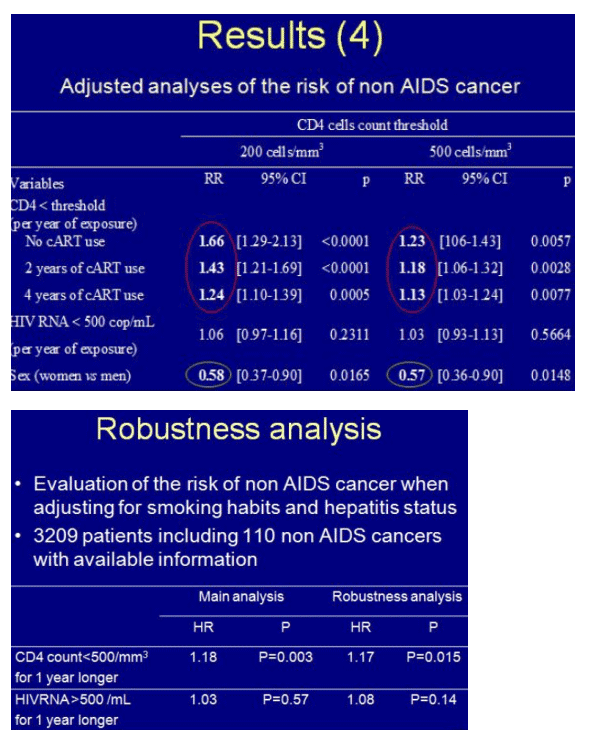
|
| |
|
 |
 |
|
|